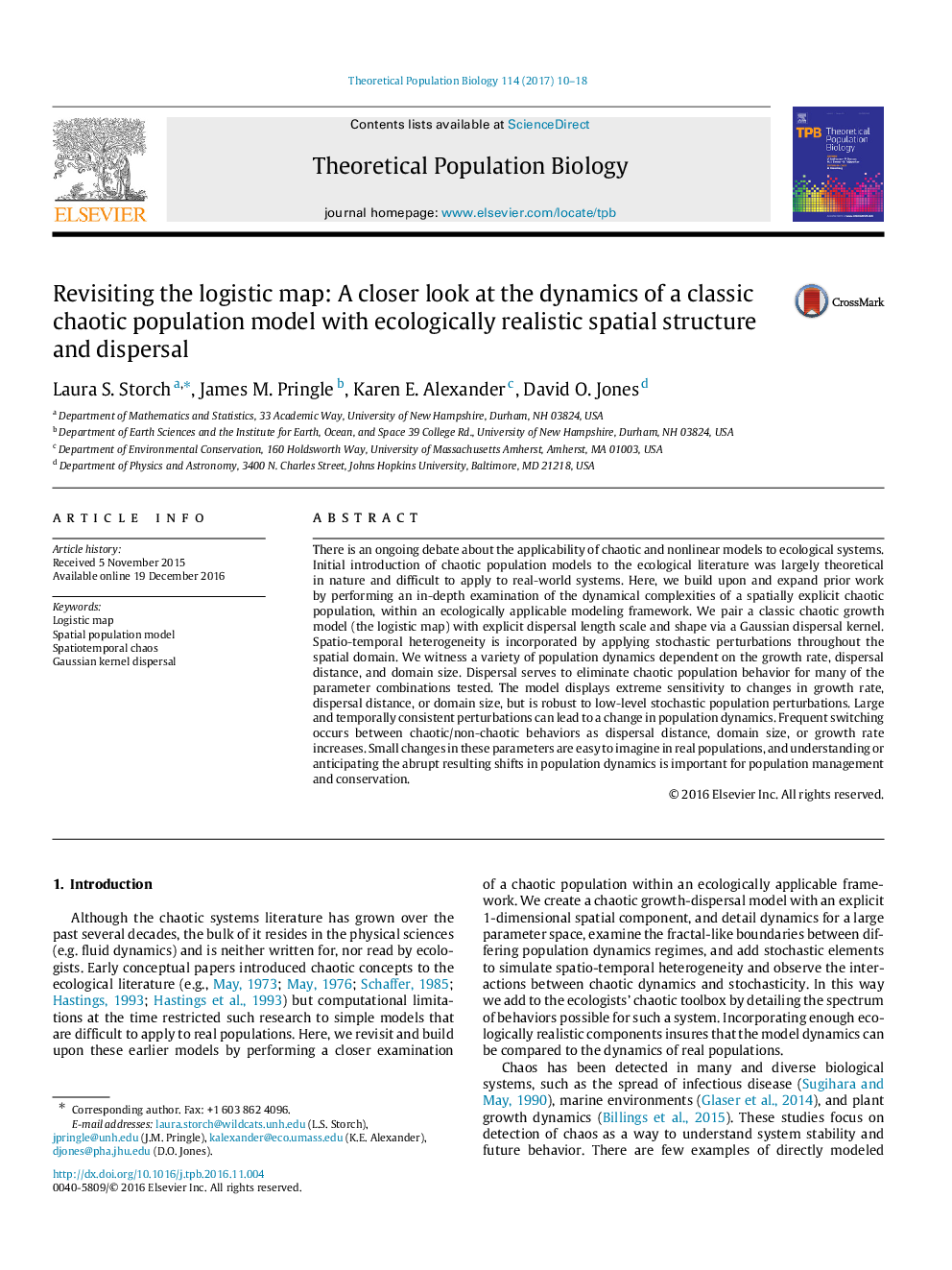| کد مقاله | کد نشریه | سال انتشار | مقاله انگلیسی | نسخه تمام متن |
|---|---|---|---|---|
| 5760583 | 1624138 | 2017 | 9 صفحه PDF | دانلود رایگان |
عنوان انگلیسی مقاله ISI
Revisiting the logistic map: A closer look at the dynamics of a classic chaotic population model with ecologically realistic spatial structure and dispersal
ترجمه فارسی عنوان
بازبینی نقشه لجستیک: نگاهی دقیق تر به پویایی یک مدل جمعیت کلاسیک هرج و مرج با ساختار فضایی محیطی و پراکندگی
دانلود مقاله + سفارش ترجمه
دانلود مقاله ISI انگلیسی
رایگان برای ایرانیان
کلمات کلیدی
ترجمه چکیده
یک بحث مداوم در مورد کاربرد مدل های هرج و مرج و غیر خطی به سیستم های زیست محیطی وجود دارد. معرفی اولیه مدل های جمعیتی هرج و مرج به ادبیات اکولوژیکی عمدتا به لحاظ نظری در طبیعت بوده و برای سیستم های دنیای واقعی دشوار است. در اینجا، ما با انجام یک بررسی عمیق از پیچیدگی های دینامیکی جمعیت هرج و مرج فضایی صریح، در یک چارچوب مدل سازی اکولوژیکی، کار را بر اساس و گسترش می دهیم. ما یک مدل رشد کلاسیک هرج و مرج (نقشه لجستیک) با مقیاس طول و پراکندگی صریح از طریق یک هسته پراکندگی گاوسی شکل می دهیم. ناهمگونی اسپکتیو-زمان با استفاده از اختلالات تصادفی در حوزه فضایی گنجانیده شده است. ما شاهد انواع مختلف پویایی جمعیت است که وابسته به نرخ رشد، فاصله پراکندگی و اندازه دامنه است. پراکندگی برای از بین بردن رفتار جمعیت هرج و مرج برای بسیاری از ترکیبات پارامتر مورد آزمایش قرار می گیرد. این مدل حساسیت شدیدی به تغییرات در نرخ رشد، فاصله پراکندگی یا اندازه دامنه دارد، اما به شدت به اختلالات جمعیتی تصادفی در سطح پایین است. اغتشاشات بزرگ و درازمدت می تواند منجر به تغییر در دینامیک جمعیت شود. سوئیچینگ مکرر بین رفتارهای آشوبآفرین / غیر هوازدگی رخ می دهد که به عنوان فاصله پراکندگی، اندازه دامنه یا رشد رشد افزایش مییابد. تغییرات کوچک در این پارامترها در جمعیت واقعی قابل تصور است و درک و پیش بینی تغییرات ناگهانی ناشی از تغییرات جمعیت برای مدیریت و حفاظت از جمعیت بسیار مهم است.
موضوعات مرتبط
علوم زیستی و بیوفناوری
علوم کشاورزی و بیولوژیک
علوم کشاورزی و بیولوژیک (عمومی)
چکیده انگلیسی
There is an ongoing debate about the applicability of chaotic and nonlinear models to ecological systems. Initial introduction of chaotic population models to the ecological literature was largely theoretical in nature and difficult to apply to real-world systems. Here, we build upon and expand prior work by performing an in-depth examination of the dynamical complexities of a spatially explicit chaotic population, within an ecologically applicable modeling framework. We pair a classic chaotic growth model (the logistic map) with explicit dispersal length scale and shape via a Gaussian dispersal kernel. Spatio-temporal heterogeneity is incorporated by applying stochastic perturbations throughout the spatial domain. We witness a variety of population dynamics dependent on the growth rate, dispersal distance, and domain size. Dispersal serves to eliminate chaotic population behavior for many of the parameter combinations tested. The model displays extreme sensitivity to changes in growth rate, dispersal distance, or domain size, but is robust to low-level stochastic population perturbations. Large and temporally consistent perturbations can lead to a change in population dynamics. Frequent switching occurs between chaotic/non-chaotic behaviors as dispersal distance, domain size, or growth rate increases. Small changes in these parameters are easy to imagine in real populations, and understanding or anticipating the abrupt resulting shifts in population dynamics is important for population management and conservation.
ناشر
Database: Elsevier - ScienceDirect (ساینس دایرکت)
Journal: Theoretical Population Biology - Volume 114, April 2017, Pages 10-18
Journal: Theoretical Population Biology - Volume 114, April 2017, Pages 10-18
نویسندگان
Laura S. Storch, James M. Pringle, Karen E. Alexander, David O. Jones,
